
The Casuarinaceae are a family of dicotyledonous flowering plants placed in the order Fagales, consisting of four genera and 91 species of trees and shrubs native to eastern Africa, Australia, Southeast Asia, Malesia, Papuasia, and the Pacific Islands. At one time, all species were placed in the genus Casuarina. Lawrence Alexander Sidney Johnson separated out many of those species and renamed them into the new genera of Gymnostoma in 1980 and 1982, Allocasuarina in 1982, and Ceuthostoma in 1988, with some additional formal descriptions of new species in each other genus. At the time, it was somewhat controversial. The monophyly of these genera was later supported in a 2003 phylogenetic study of the family. In the Wettstein system, this family was the only one placed in the order Verticillatae. Likewise, in the Engler, Cronquist, and Kubitzki systems, the Casuarinaceae were the only family placed in the order Casuarinales.

Casuarina equisetifolia, commonly known as coastal she-oak, horsetail she-oak, ironwood,beach sheoak, beach casuarina or whistling tree is a species of flowering plant in the family Casuarinaceae and is native to Australia, New Guinea, Southeast Asia and India. It is a small to medium-sized, monoecious tree with scaly or furrowed bark on older specimens, drooping branchlets, the leaves reduced to scales in whorls of 7 or 8, the fruit 10–24 mm (0.39–0.94 in) long containing winged seeds (samaras) 6–8 mm (0.24–0.31 in) long. It has been called ironwood, horsetair tree, beach sheoak, and Australian pine, though it is not pine despite some of its conifer like features.

Casuarina, also known as Australian pine and native pine, is a genus of flowering plants in the family Casuarinaceae, and is native to Australia, the Indian subcontinent, Southeast Asia, islands of the western Pacific Ocean, and eastern Africa.

Allocasuarina torulosa, commonly known as forest oak, rose sheoak, river oak or Baker's oak, is a species of flowering plant in the family Casuarinaceae and is endemic to eastern Australia. It is a slender, usually dioecious tree that has drooping branchlets up to 140 mm (5.5 in) long, the leaves reduced to scales in whorls of four or five, and the fruiting cones 15–33 mm (0.59–1.30 in) long containing winged seeds 7–10 mm (0.28–0.39 in) long.

Allocasuarina humilis, commonly known as dwarf sheoak, is a species of flowering plant in the family Casuarinaceae and is endemic to the south-west of Western Australia. It is an erect or spreading dioecious or monoecious shrub that has its leaves reduced to scales in whorls of five to seven, the mature fruiting cones 12–22 mm (0.47–0.87 in) long containing winged seeds (samaras) 5–6 mm (0.20–0.24 in) long.

Allocasuarina distyla, commonly known as scrub she-oak, is a species of flowering plant in the family Casuarinaceae and is endemic to south-eastern New South Wales. It is a dioecious shrub that has branchlets up to 350 mm (14 in) long, the leaves reduced to scales in whorls of six to eight, the fruiting cones 13–35 mm (0.51–1.38 in) long containing winged seeds (samaras) 4.0–8.0 mm (0.16–0.31 in) long.
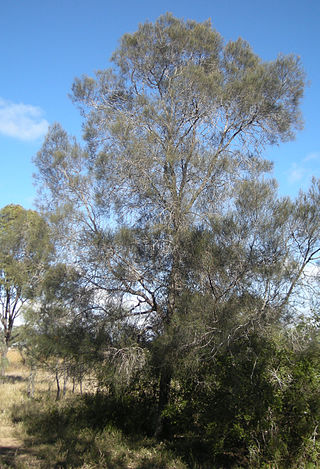
Allocasuarina luehmannii, commonly known as buloke or bull-oak, is a species of flowering plant in the family Casuarinaceae and is endemic to south-eastern continental Australia. It is a dioecious tree, that has its leaves reduced to scales in whorls of ten to fourteen, and the mature fruiting cones are 5–12 mm (0.20–0.47 in) long containing winged seeds (samaras) 4–5 mm (0.16–0.20 in) long.

Allocasuarina decaisneana, commonly known as desert oak, desert sheoak, or kurkara by the Anangu peoples, is a species of flowering plant in the family Casuarinaceae and is endemic to Central Australia. It is a dioecious tree that typically grows to a height of 10–16 m (33–52 ft) and has long, drooping branchlets, the leaves reduced to scales in whorls of four, the mature fruiting cones 28–95 mm (1.1–3.7 in) long containing winged seeds (samaras) 8.5–17 mm (0.33–0.67 in) long.

Casuarina cunninghamiana, commonly known as river oak, river sheoak or creek oak, is a species of flowering plant in the family Casuarinaceae and is native to Australia and New Guinea. It is a tree with fissured and scaly bark, sometimes drooping branchlets, the leaves reduced to scales in whorls of 6 to 10, the fruit 7–14 mm (0.28–0.55 in) long containing winged seeds (samaras) 3–4 mm (0.12–0.16 in) long.

Allocasuarina verticillata, commonly known as drooping sheoak, is a species of flowering plant in the family Casuarinaceae and is endemic to south-eastern Australia. It is a small dioecious tree that has drooping branchlets up to 400 mm (16 in) long, the leaves reduced to scales in whorls of nine to thirteen, the mature fruiting cones 20–50 mm (0.79–1.97 in) long containing winged seeds 7–12 mm (0.28–0.47 in) long.

Allocasuarina littoralis, commonly known as black she-oak, is a species of flowering plant in the family Casuarinaceae and is endemic to eastern Australia. It is dioecious, or less commonly a monoecious tree or shrub, that has its leaves reduced to scales, usually in whorls of six to eight, the mature fruiting cones 10–30 mm (0.39–1.18 in) long containing winged seeds (samaras) 4.0–10 mm (0.16–0.39 in) long.
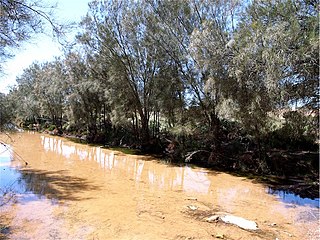
Casuarina obesa, commonly known as swamp she-oak, swamp oak or western swamp oak, or as goolee, kweela, kwerl and quilinock by the Noongar peoples, is a species of flowering plant in the family Casuarinaceae and is endemic to southern continental Australia. It is a dioecious small tree or shrub that forms root suckers, and has drooping or spreading branchlets, the leaves reduced to scales in whorls of 12 to 16, the fruit 10–20 mm (0.39–0.79 in) long containing winged seeds (samaras) 3–5 mm (0.12–0.20 in) long.
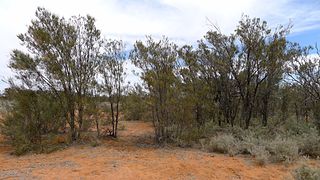
Casuarina pauper, commonly known as black oak, belah or kariku, is a species of flowering plant in the family Casuarinaceae and is endemic to southern continental Australia. It is a dioecious tree with fissured or scaly bark, waxy branchlets, the leaves reduced to scales in whorls of 9 to 13, the fruit 13–18 mm (0.51–0.71 in) long containing winged seeds (samaras) 5.5–7.0 mm (0.22–0.28 in) long.
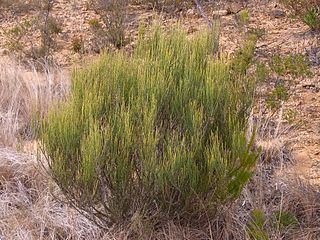
Allocasuarina nana, commonly known as dwarf she-oak or as stunted sheoak, is a species of flowering plant in the family Casuarinaceae and is endemic to south-eastern continental Australia. It is a low, spreading dioecious, rarely monoecious shrub that has branchlets up to 80 mm (3.1 in) long, the leaves reduced to scales in whorls of four to six, the fruiting cones 14–24 mm (0.55–0.94 in) long containing winged seeds 4–6 mm (0.16–0.24 in) long.

Casuarina cristata, commonly known as belah or muurrgu, is a species of flowering plant in the family Casuarinaceae and is endemic to inland eastern Australia. It is a tree with fissured or scaly bark, sometimes drooping branchlets, the leaves reduced to scales in whorls of 8 to 12, the fruit 13–18 mm (0.51–0.71 in) long containing winged seeds (samaras) 6.0–10.5 mm (0.24–0.41 in) long.

Allocasuarina inophloia, commonly known as stringybark she-oak, is a species of flowering plant in the family Casuarinaceae and is endemic to eastern Australia. It is a small dioecious tree that has finely fibrous, ribbony bark, its leaves reduced to scales in whorls of seven to nine, the mature fruiting cones 10–20 mm (0.39–0.79 in) long containing winged seeds (samaras) 5–6 mm (0.20–0.24 in) long.

Allocasuarina paludosa, commonly known as swamp she-oak or scrub sheoak, is a species of flowering plant in the family Casuarinaceae and is endemic to south-eastern continental Australia. It is a monoecious or dioecious shrub that has branchlets up to 200 mm (7.9 in) long, the leaves reduced to scales in whorls of six to eight, the fruiting cones 10–18 mm (0.39–0.71 in) long containing winged seeds 3.5–5.0 mm (0.14–0.20 in) long.
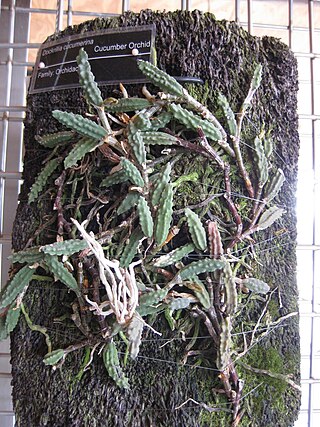
Dendrobium cucumerinum, commonly known as the cucumber orchid or gherkin orchid, is a species of orchid endemic to eastern Australia. It is an epiphytic orchid with creeping stems, gherkin-like leaves and flowering stems with up to eighteen cream-coloured, yellowish or greenish white flowers with purple stripes. It often grows on large trees near streams but is also found in drier forests.

Allocasuarina pusilla, commonly known as heath oak-bush or dwarf sheoak, is a species of flowering plant in the family Casuarinaceae and is endemic to south-eastern continental Australia. It is a spreading, dioecious shrub with branchlets up to 120 mm (4.7 in) long, the leaves reduced to scales in whorls of five to seven, the fruiting cones 10–15 mm (0.39–0.59 in) long containing winged seeds about 5 mm (0.20 in) long.

Allocasuarina rigida is a species of flowering plant in the family Casuarinaceae and is endemic to eastern Australia. It is a dioecious shrub that has branchlets up to 330 mm (13 in) long, the leaves reduced to scales in whorls of seven to ten, and the fruiting cones 8–27 mm (0.31–1.06 in) long containing winged seeds 3.0–7.5 mm (0.12–0.30 in) long.
























